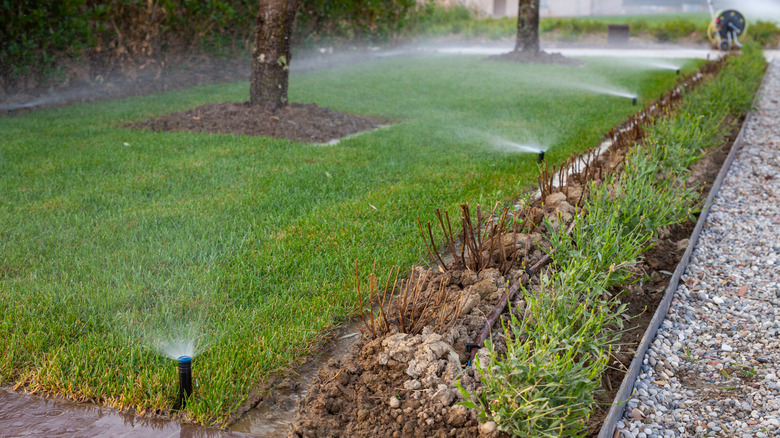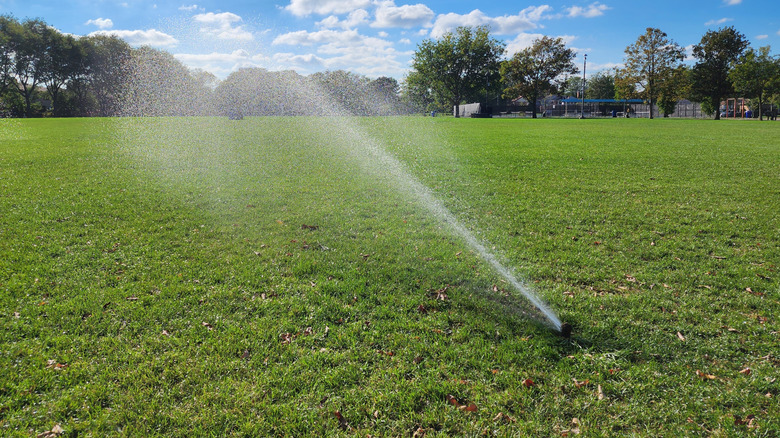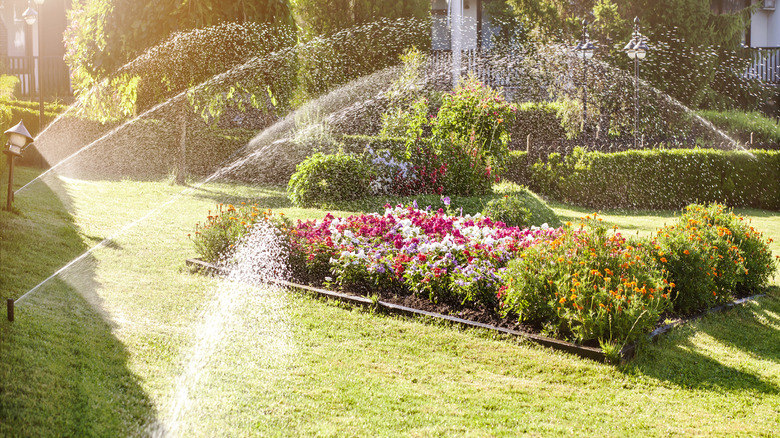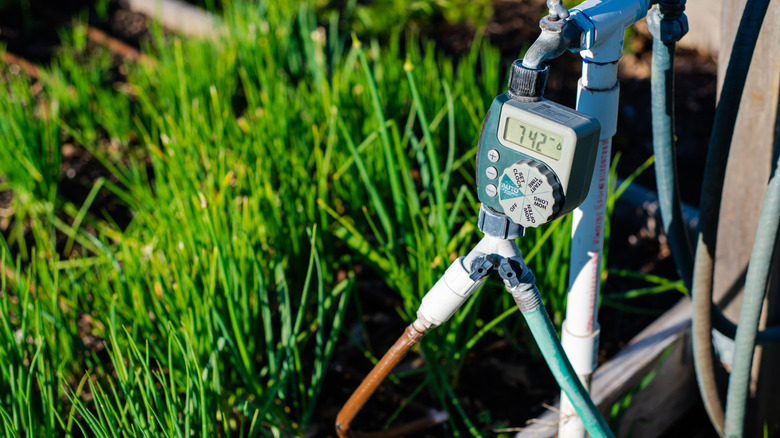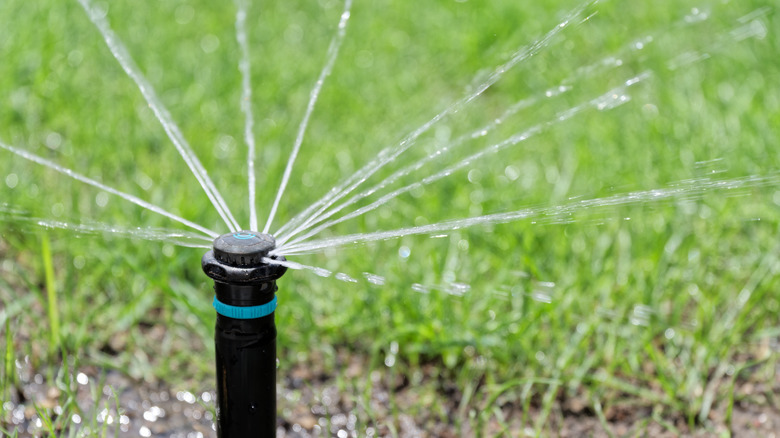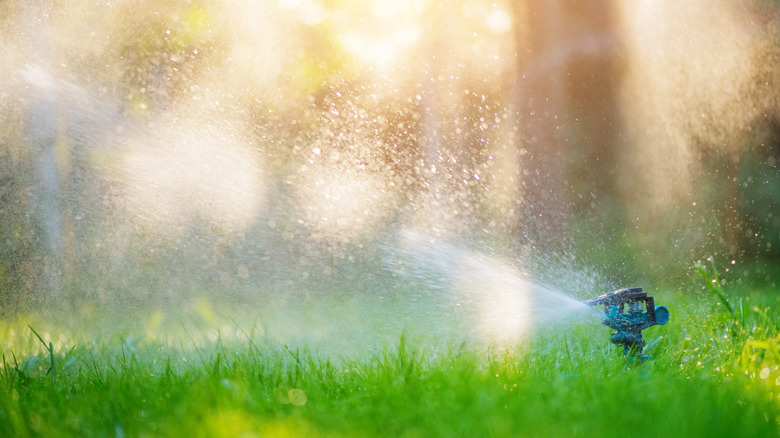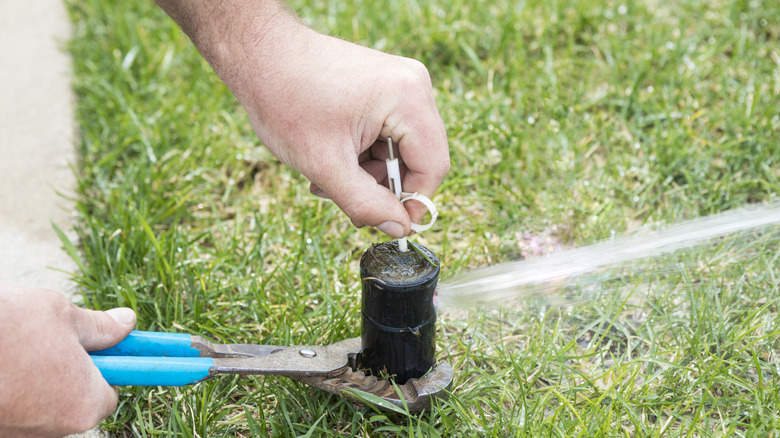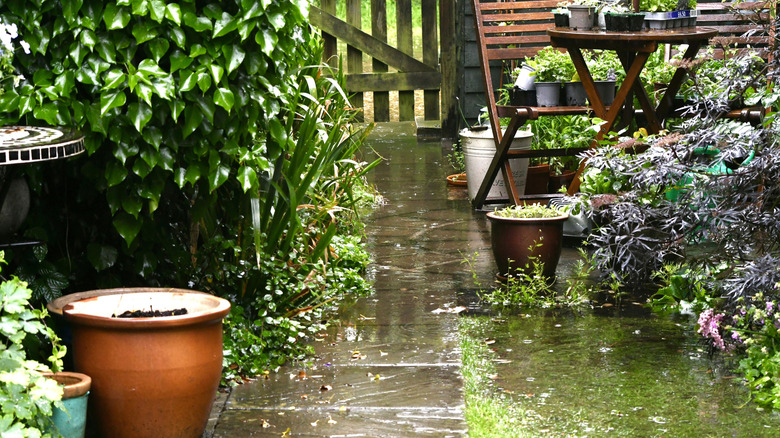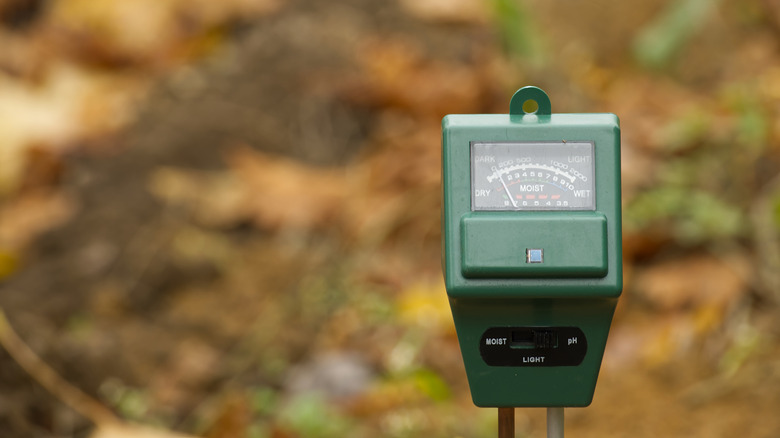How To Fine-Tune Your Sprinkler System To Cut Down On Expenses And Conserve Water
We may receive a commission on purchases made from links.
Anyone who has ever maintained a lush and beautifully manicured lawn knows that a lot of time and effort goes into keeping it looking its best. While your green thumb definitely plays a big role in the beauty of your yard, there's no denying the fact that your sprinkler system deserves some credit, too. And while sprinkler systems play an important role in lawn care, they can also play an expensive one. During the summer months, your sprinkler system can increase your water bill by $50 to $200, depending on your watering schedule and the size of your yard.
There's no way to completely eliminate this extra expense. However, there are things you can do to ensure that your sprinkler system is as efficient as possible, lowering your usage and saving some money. Let's take a look at how you can fine-tune your system to cut down on expenses and conserve water.
Regulate your water pressure
Water pressure isn't just important for sinks and showers; it also matters to your sprinkler system. If your water pressure is too low, it can reduce your sprinkler system's coverage, which could eventually result in brown spots in your grass. High water pressure can also cause uneven coverage because it can make water mist from your sprinkler heads. On top of that, high water pressure can also result in wasted water and can even damage your sprinkler system over time. Needless to say, it's important to get your water pressure in check.
According to experts, residential water pressure should be between 40 and 60 pounds per square inch (psi). Investing in a water pressure regulator can help ensure that your water pressure stays in the proper range. These are installed between your water supply and your sprinkler system and work by sensing your water pressure and adjusting it accordingly. The cost of having a water pressure regulator installed typically averages between $300 and $650. Since plumbing skills are required for this installation, it's generally not recommended to do it yourself.
Ensure your system is zoned properly
All of the areas in your yard aren't created equal, and there are some places that may need more or less water than others. This is where zones come into play. Each zone in your yard is made up of its own group of sprinkler heads that operate from the same valve. For your system to operate efficiently, it's important to have your yard zoned correctly and have the right sprinkler heads set up in each one. Otherwise, you could be overwatering certain areas of your yard, leading to increased expenses.
The first step is to map out your yard to identify where all of the plants and shrubs are located, while also taking into account how much sunlight certain areas of your yard get. This will allow you to define your zones and determine how much water and what kind of sprinkler head each area needs. Although the number of zones you should have is ultimately determined by the size of your yard, 6-9 zones is the norm.
Use a sprinkler timer
When most people think of the benefit of a sprinkler timer, convenience is the first thing that comes to mind. After all, it's nice to know that your yard can still get watered without you having to be there to do it. However, that isn't the only reason sprinkler timers come in handy. They also play a big role in conserving water because they run for a predetermined amount of time. Sprinkler timers also help your water conservation efforts because they can be set to only water one zone of your yard at a time.
When considering a sprinkler timer for your yard, keep in mind that there are three types: mechanical, electric, and hybrid. Mechanical timers are the most cost-effective option, but they must be set manually and offer a little less flexibility and control than the other options. On the other hand, many hybrid and electric options can be controlled from a cell phone or other smart device, which allows you to easily make adjustments as needed.
Consider rotary sprinkler heads
Rotary sprinkler heads, also called rotor sprinklers, are designed with a rotating nozzle that moves in a circular motion while spraying water. The sprinkler heads pop up at their scheduled time and start distributing water throughout your yard. According to experts, rotary sprinklers work best in medium to large yards because they cover a wider area than spray sprinklers.
Rotary sprinklers can help you reduce your water bill because they distribute water evenly and in larger drops that are less likely to be dispersed into the air. This also cuts down on the likelihood of some areas being overwatered. Another benefit of rotary sprinklers is that they don't clog easily, which not only makes them easier to maintain but also adds to their water-saving skills. If you opt for high-efficiency rotary nozzles, you can simply unscrew your existing nozzles and replace them with a rotary nozzle.
Keep those sprinkler heads clean
Cleaning your sprinkler heads may not be one of the first things on your lawn care priority list. But did you know that dirty sprinkler heads can lead to clogs that can result in your sprinkler system performing less efficiently? Clogged and dirty sprinkler heads can cause uneven coverage, poor water distribution, and restricted water flow. As you may have guessed, all of these things can help lead to wasted water and a higher bill.
To avoid these problems, you should clean your sprinkler heads once or twice a year. In most cases, you can clean your sprinklers without the help of a professional by simply pulling your sprinkler heads up, removing and wiping the filters, and soaking the heads in soap and water. If your sprinkler heads are especially dirty, you can put some rust remover into your soap and water while soaking.
Check for leaks
You're probably already aware of how detrimental water leaks can be inside your home, but they can also be a problem when it comes to your sprinkler system. Unfortunately, though, leaks in your sprinkler system aren't always easy to find. As a result, it's important to regularly check your system.
One main indicator of a water leak is an unusually high water bill. Another one of the first things you'll want to look for is pooling water, which could indicate that you have a damaged valve. Other easily overlooked indicators of a leak include wilted or dead plants and wet spots on the pavement. If you do suspect a leak in your sprinkler system, you should shut off the water supply and contact an experienced professional who can assess the situation and help you determine what your next steps should be.
Invest in a rain/freeze sensor
One of the biggest perks of having an automatic sprinkler system is that you can set it to water your lawn on a schedule. Unfortunately, sometimes the weather and your plans aren't always on the same page, and the last thing you want is for your sprinklers to be running in the rain. Fortunately, a rain/freeze sensor can prevent this from happening. This device is designed to detect rain and freezing temperatures and prevent the sprinkler system from running.
Wired rain/freeze sensors can be purchased for around $20, while wireless options, like the Rain Bird, can be purchased for around $85. These sensors can help reduce your water usage and help prevent your lawn from being overwatered. Experts suggest inspecting your sensor every year to ensure that it's functioning properly. It's also important to note that sprinkler sensors with the WaterSense label can save around 15,000 gallons of water per year. According to the United States Environmental Protection Agency, if every home in the country had a weather-based sensor, nearly 400 billion gallons of water would be saved annually.
Install soil moisture sensors
Rain/freeze sensors aren't the only ones that can help your sprinkler system operate more efficiently. The WaterSense label (and water-saving benefits) can also be applied to soil moisture sensors. As the name suggests, these work by detecting the amount of moisture in your soil. This differs from rain/freeze sensors, which detect rainfall and freezing temperatures in real-time. Moisture sensors prevent your sprinkler system from starting if the moisture levels are too high, which cuts down on wasted water and helps you maintain a healthy lawn.
Soil moisture sensors are broken down into three main types: capacitive, time domain reflectometry (TDR), and frequency domain reflectometry (FDR). However, it's recommended to contact a professional to determine which sensor type makes the most sense for your property. These can be placed in specific zones to monitor levels and automatically tweak the watering schedule for the area. That way, you're system only waters when and where it's needed, saving water.
